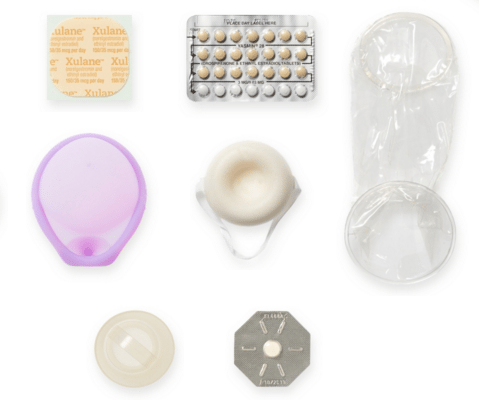By Literary Women in Action
Image from Bedsider
It may be hard to imagine but there was a time when women in this country could be arrested for using birth control. Having access to affordable, safe birth control is a right that was hard won for women and is continually fought for. You have every right to make informed, smart decisions about what is best for your own body.
Selecting the birth control option that is best for you is an important and personal decision. You will want to consider your lifestyle and personality to determine which option will be the most effective for you. While there are many different options available, it isn’t always easy to find good information that explains the differences between the various options available. You will need to schedule an appointment with a doctor to get many birth control options, but you can also do some research on your own beforehand. (If you need birth control without parental consent, make an appointment at one of these clinics.)
In this post, I will help you sift through the various options you have available by organizing your options by LARCs, Hormonal methods, and Barrier methods.
| What is a LARC?
LARC stands for long-acting reversible contraceptives. LARCs are typically considered the most effective birth control because they work without you having to do anything. This means you don’t have to plan ahead before sex or remember to take a pill every-day at the same time. They just work! The following are the most common LARCs available: |
|||
| Method | Brief Description | The upside | The downside |
| IUD | A T-shaped device that is placed in your uterus and disrupts the way sperm moves preventing it from fertilizing an egg. | •99% effective!
•Inserted once and lasts for years •No one can tell you have it inserted • Doesn’t interrupt the heat of the moment |
•You need a medical provider to insert it.
•Side effects including spotting between periods, cramping, heavier periods •Some IUDs have hormones, so if you are avoiding hormones you may want to stay away from those. But there are IUDs that don’t have hormones. |
| Implant | A tiny rod about the size of a match stick that is inserted under the skin of your upper arm. The implant releases progestin, a hormone that keeps your ovaries from releasing eggs and thickens your cervical mucus. | •99% effective!
•It prevents pregnancy for up to 4 years. • Very hard to tell you have it in your arm •Doesn’t interrupt the heat of the moment •Some women have fewer, lighter periods |
You need a medical provider to insert it.
The most common complaint is irregular bleeding, especially for the first 6-12 months |
| What is hormonal birth control?
Hormonal birth control is any type of method that uses hormones to prevent an egg from being released every month or prevent a fertilized egg from implanting in the uterus. The following are the most common types of hormonal birth control
|
|||
| Method | Brief Description | The upside | The downside |
| The pill | The most commonly known form of hormonal birth control. There are two types of pills available: Combination, which uses estrogen/progestin to your ovaries from releasing eggs (ovulation), and Progestin only, known as the mini-pill and are good if you are sensitive to the combination pill. | •Easy to use – just swallow with water
•Doesn’t interrupt the heat of the moment •Can give you lighter or more regular periods •Can reduce cramps and PMS •Some pills clear up acne •Some pills can protect against health problems, like endometrial and ovarian cancer, iron deficiency anemia, ovarian cysts, and pelvic inflammatory disease |
•Have to be taken at the same time every day and this can be difficult to remember.
•If you want to be discreet, you may have to hide the pill package. •Can cause nausea and vomiting •Breast tenderness |
| The patch | The patch is just like the pill except you place it somewhere on your skin. You can place it on your arm, stomach, upper torso, or butt. Like the pill the patch gives off hormones that prevents ovulation. | •Unlike with the pill, with the patch you only have to remember to something once a week.
•Doesn’t interrupt the heat of the moment •May clear up acne •Can reduce cramps and PMS •Can give you lighter or more regular periods |
•You still have to remember something even if it is only once a week
•The patch could be seen on your skin •Bleeding in between periods •Breast tenderness •Nausea and vomiting |
| The shot | The “shot” is also known as the Depo shot, short for Depo Provera. It’s a shot of the hormone progestin that keeps you from getting pregnant for three months. Like the pill and the patch the shot prevents ovulation. | •It’s very effective, as long as you get the shot on time.
•Doesn’t interrupt the heat of the moment •Is very private, no one will know unless you tell them •You only have to remember something once every three months •Might give you shorter, lighter periods—or no periods at all |
•Irregular bleeding, especially for the first 6 to 12 months
•Change in appetite or weight gain |
| Vaginal Ring (Nuva Ring) | The ring is a small, transparent plastic ring that is put in your vagina, like a tampon, and kept there for 3 weeks. The ring uses the same hormones as other hormonal birth control to prevent ovulation. | •Easy to use – just like putting in a tampon
•Doesn’t interrupt the heat of the moment •Only have to remember something once every 3 weeks. •May clear up acne •Might give you shorter, lighter periods |
•Bleeding in between periods
•Breast tenderness •Nausea and vomiting •Could cause infections, such as yeast infections •Some partners can feel it but it’s easy to take out – but be sure to remember to put it back in within 3 hours! |
| What is barrier birth control?
Barrier birth control prevents sperm from reaching the egg. |
|||
| Method | Brief description | Upside | Downside |
| Condoms | Probably the most commonly known barrier method is the condom. It covers the penis and prevents sperm from entering the vagina. | •Prevents STIs
•Cheap and easy to get a hold of •No prescription necessary •May help with premature ejaculation |
•No side effects unless you’re allergic to latex, although non-latex condoms are available.
•They take effort and commitment – You have to use them correctly every time for them to be effective. |
| Diaphragm | A shallow, dome-shaped cup made of silicone. It’s silly looking but it does work. You put the diaphragm in your vagina and it covers your cervix so sperm doesn’t get into the uterus. You have to use spermicide for it to be effective. | •You can put a diaphragm in hours in advance
•With spermicide it is effective •Doesn’t affect your hormones |
•It takes discipline
•It can be tricky to insert for some women •It can shift around with some sexual positions and heavy thrusting •Some women wind up getting frequent urinary tract infections •You need a prescription •Could be hard to remember in the heat of the moment |
| Sponge | A round piece of white, plastic foam with a little indentation and piece of nylon loop across the top. It blocks your cervix and it releases spermicide. | • You can put a sponge in up to 24 hours in advance
• Neither you or your partner will feel it • No prescription required • Doesn’t affect your hormones |
• Some women have a hard time inserting it
• Can cause vaginal irritation • Can make sex messier • Could be hard to remember in the heat of the moment |
| Spermicides | Spermicide” describes a bunch of different creams, films, foams, gels, and suppositories that contain chemicals that stop sperm from moving | • Easy to use and get
•No prescription required •Doesn’t affect your hormones
|
• Can make sex messier
• Could be hard to remember in the heat of the moment • Might irritate your vagina or your partner’s penis |
As you look at these available options some key things to consider are: how good are you at keeping a routine, can you tolerate some of the potential side hormonal effects, and will you be able to remember your birth control in the heat of the moment.
Bedsider has an amazing series of videos where people, including teens, share their experiences with birth control.
One friend I spoke with, aged 24, considered these things about herself when she made her choice to move from the NuvaRing to the IUD. She knew she would be bad at taking pills at the same time every day so she initially chose the NuvaRing, when she was 20, because she wouldn’t have to think about it every day. “My gynecologist gave me a free sample of the ring and I loved it. It was just like inserting a tampon and I couldn’t feel it at all. It just chills in your vagina, you don’t notice it at all. And I only had to remember it every three weeks.”
She said the NuvaRing was a great choice for her as a young woman and a great choice for teens. She was able to have unprotected sex with an exclusive partner for a year and a half without a pregnancy scare. That would have been harder for her with the pill, because it’s so easy to forget to take them at the right time.
She also liked that the NuvaRing gave her an opportunity to include her partner in her choice of birth control. Explaining before sex that she used the ring was also a good time to check in with them about STDs and consent. She went on to explain that, “most guys were more intrigued than anything, they hadn’t heard of the ring and were interested to see how it felt, know how it worked, etc,”
She moved to the IUD in December 2016 because she got tired of refilling the ring prescriptions, and having to scramble to refill the pack on the last day could be stressful. She said, “The IUD insertion did suck and was painful.” Unlike the ring that sits in your vagina like a tampon the IUD is in your uterus past your cervix. As she explained, “Your body does not like anything going through your cervix – the whole function of the cervix is to keep everything except sperm out! So the insertion is painful with lots of cramping.” But she loves not having to worry about birth control for 5 years! And with the election and so many extreme politicians pushing agendas that could make it harder to get affordable birth control, she likes knowing she is covered.
Birth control unfortunately is a topic that some people find uncomfortable to talk about and you may be embarrassed to bring it up with others. However, many of your friends or supportive adults in your life have probably thought about birth control as well, and may have lots of stories to share once you ask. Bedsider is also a great resource for all birth control information. Their app also will provide you with apps to help remind you of when to refill prescriptions, take pills, or insert the ring.
Good luck in your search and remember if you experiment with different methods always make sure you are protected while you move from one to another.




